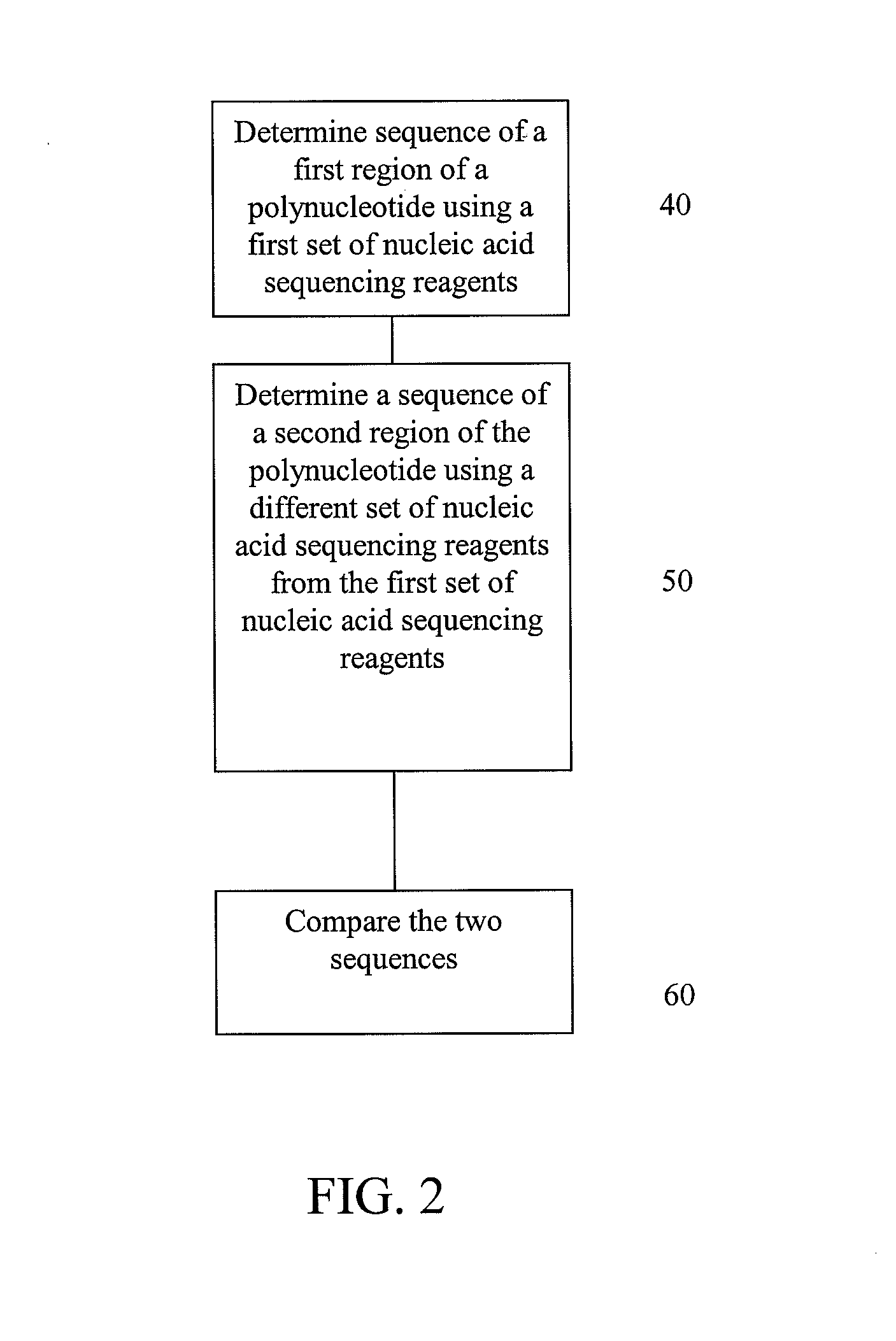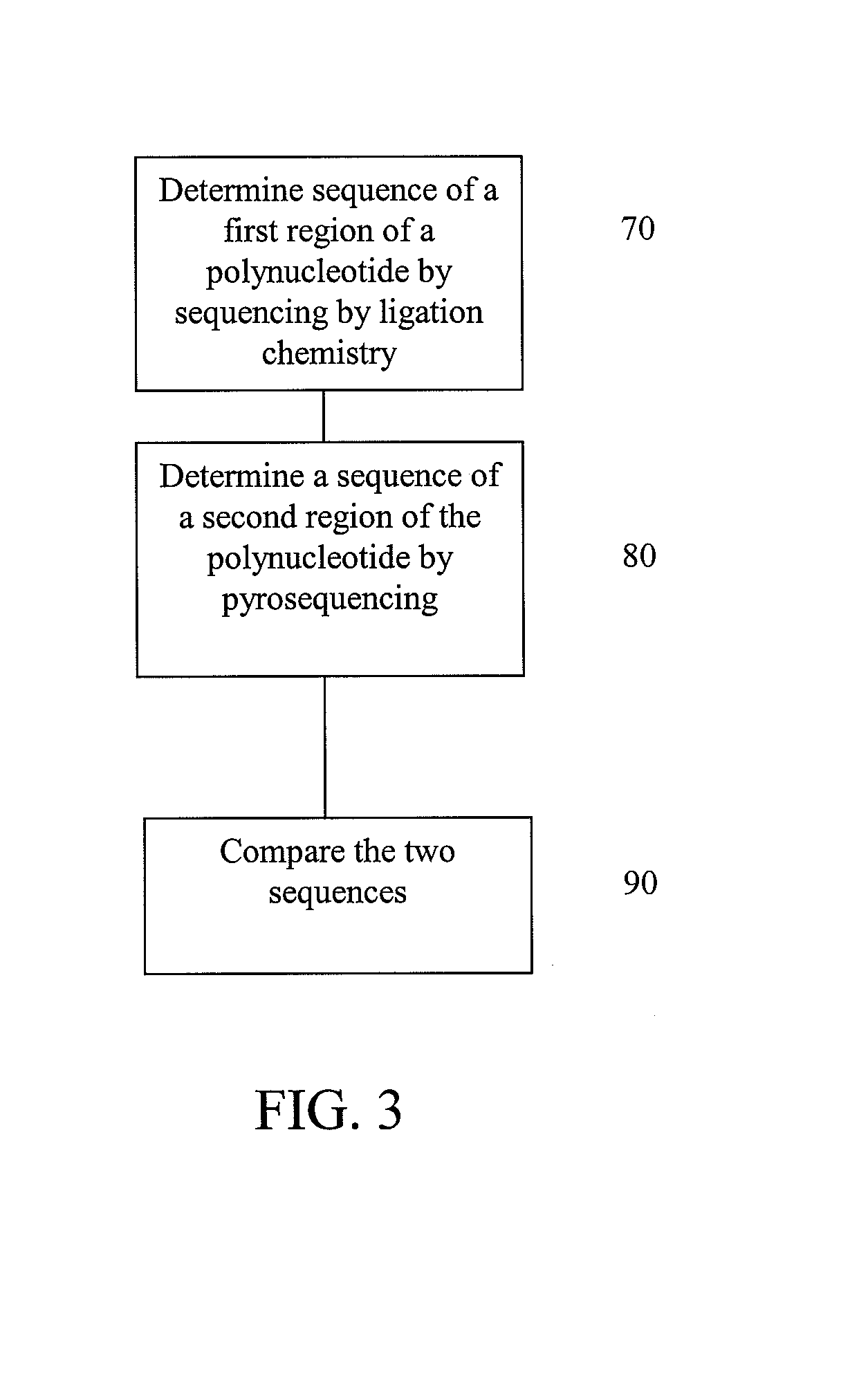Alternative nucleic acid sequencing methods
a technology of nucleic acid and composition, applied in the field of compositions and methods for nucleic acid sequencing, can solve problems such as uncertainty in the obtained sequence, and achieve the effects of facilitating more effective sequencing, facilitating greater read length, and more accurate nucleic acid sequencing
- Summary
- Abstract
- Description
- Claims
- Application Information
AI Technical Summary
Benefits of technology
Problems solved by technology
Method used
Image
Examples
example 1
[0093]This example illustrates possible methods for analysis of a polynucleotide sequence by sequencing two regions of the polynucleotide using sequencing by ligation and pyrosequencing.
[0094]The polynucleotide for sequencing is prepared by fragmenting the polynucleotide and clonally amplifying the fragments through emulsion PCR as described below. After amplification, a first region of the polynucleotide is subjected to sequencing using sequencing by ligation, as described below, to determine a first sequence (FIG. 3 at 70). Next, a second region of the polynucleotide is subjected to pyrosequencing, as described below, using to determine a second sequence (FIG. 3 at 80). The first sequence is compared to the second sequence (FIG. 3 at 90). Concordance or discordance between the data from the two different chemistries can be taken into account when making a final base call for a given position. Variations in the base and sequence biases of the different chemistries may be also be ta...
example 2
[0095]This example illustrates possible methods for analysis of a polynucleotide sequence by sequencing two regions of the polynucleotide using sequencing by ligation and pyrosequencing.
[0096]The polynucleotide for sequencing is prepared by fragmenting the polynucleotide and clonally amplifying the fragments through emulsion PCR as described below. After amplification, a first region of the polynucleotide is subjected to sequencing using sequencing by ligation, as described below, to determine a first sequence. Next, a second region of the polynucleotide is subjected to sequencing using reversible terminators to determine a second sequence. The first sequence is compared to the second sequence. Concordance or discordance between the data from the two different chemistries can be taken into account when making a final base call for a given position. Variations in the base and sequence biases of the different chemistries may be also be taken into account when making a final sequence d...
example 3
[0097]This example illustrates possible methods for analysis of a polynucleotide sequence by sequencing two regions of the polynucleotide using sequencing by ligation and pyrosequencing.
[0098]The polynucleotide for sequencing is prepared by fragmenting the polynucleotide and clonally amplifying the fragments through emulsion PCR as described below. After amplification, a first region of the polynucleotide is subjected to sequencing using reversible terminators to determine a first sequence. Next, a second region of the polynucleotide is subjected to pyrosequencing, as described below, using to determine a second sequence. The first sequence is compared to the second sequence. Concordance or discordance between the data from the two different chemistries can be taken into account when making a final base call for a given position. Variations in the base and sequence biases of the different chemistries may be also be taken into account when making a final sequence determination.
PUM
| Property | Measurement | Unit |
|---|---|---|
| total volume | aaaaa | aaaaa |
| pH | aaaaa | aaaaa |
| pH | aaaaa | aaaaa |
Abstract
Description
Claims
Application Information
 Login to View More
Login to View More - R&D
- Intellectual Property
- Life Sciences
- Materials
- Tech Scout
- Unparalleled Data Quality
- Higher Quality Content
- 60% Fewer Hallucinations
Browse by: Latest US Patents, China's latest patents, Technical Efficacy Thesaurus, Application Domain, Technology Topic, Popular Technical Reports.
© 2025 PatSnap. All rights reserved.Legal|Privacy policy|Modern Slavery Act Transparency Statement|Sitemap|About US| Contact US: help@patsnap.com



